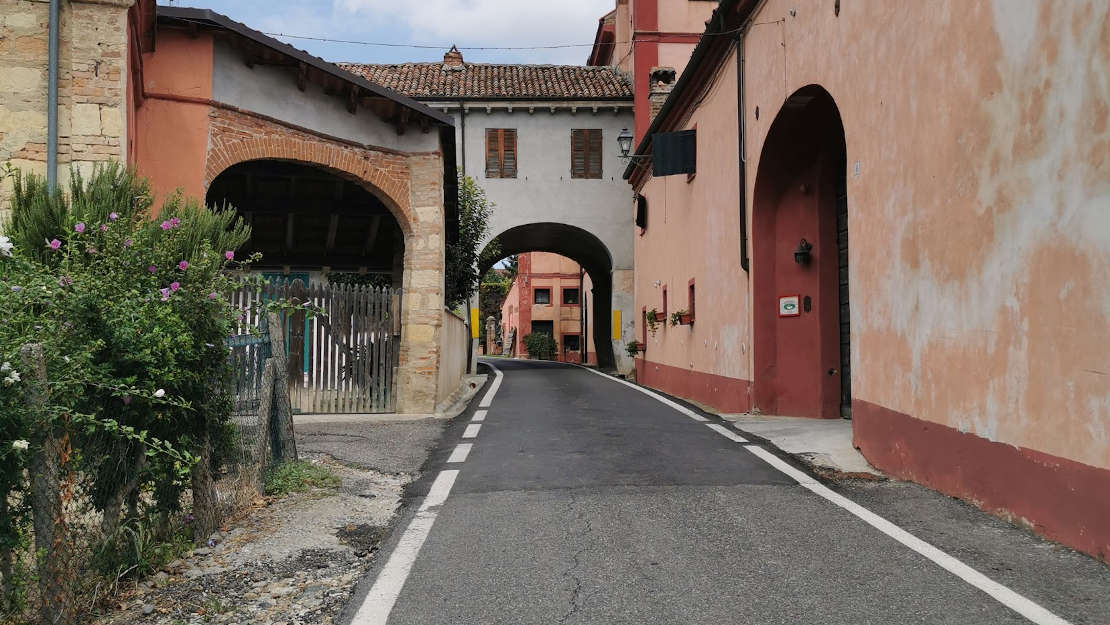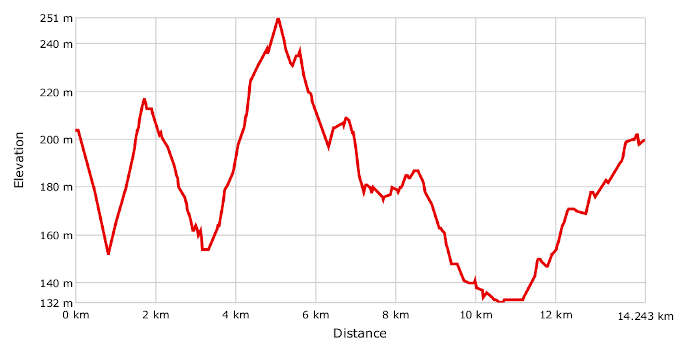
- Bike: strada/trekking
- Difficulty: *
- Distance: 15 km
- Altitude difference: 119 m
- Total ascent: 277 m
- Total descent: 281 m

This route is intended for those with less athletic training, families who want to discover the rural side of Monferrato Casalese (in the village of Rosignano Monferrato) in the space of a few kilometres, and those who want to go wine-tasting or sample local products.
It is dedicated to Saint Martin of Tours, who is known for giving half of his cloak to a beggar he met on the road. The feast of St Martin is celebrated on 11 November in associated with what we call an ‘Indian summer’ but Italians call a ‘summer of San Martino’.
Many Italian towns and villages make a big deal of this feast day, including poet Giosuè Carducci who took inspiration from the saint to write one of his most celebrated poems, ‘San Martino’, in which he sings how ‘…from the foaming vats comes the sharp smell of the wines’. That’s the smell of the autumn in Monferrato because ‘on the feast of San Martino every must becomes wine’ and, as they say in Piedmontese, ‘a San Martin deurb ël botal e tasta ‘l vin’ (on the feast of San Martino, open the cask and taste the wine because it’s now ready to drink).
You can of course take this bike ride throughout the year.
In the hamlet of Castagnoni in Rosignano, one point on the route, you can hire e-bikes at the Castagnoni Relais & Spa accommodation facility. It is possible to spend a relaxing weekend here, starting off on the route after a visit of the splendid 18th-century garden.
In San Martino di Rosignano Monferrato, start from St Giovanni Bosco square where there’s convenient parking in front of the Chapel of the Vergine Immacolata di Lourdes, which is only open on special occasions. Head left on Via Castelli. Go down on Via Luparia, passing in front of the Vincenzo Luparia agricultural school, which has educated thousands of young people over the years. A particular characteristic of this school is experimentation in the wine-making and olive-growing. It is also home to the office of the CO.BAR (consortium to preserve the Barbesino Red Wine of the Monferrato Hills. There is an infernot, which can be visited on request. Cycle down from the school on the road the locals call ‘Pcinna’, which means short but steep. Climb again, making use of momentum from the drop, until you get to Castagnoni. Continue on little roads encircled by vineyards to the hamlet of Berroni, then come down towards Cascine Ferraris and drop right down into the little valley of Garriano. From this peaceful hamlet, climb to the top of the hill from which you can see the quarries on the right and San Bartolomeo Castle in Colma di Rosignano Monferrato above. This location is known for Villa Maria, summer home of the divisionist painter Angelo Morbelli (see Route).
Come to the hamlet of Roveto (the farmstead of the same name houses a winery) and continue to Uviglie Castle. From here you can enjoy a fine view of the villages of Rosignano Monferrato and Cella Monte. This land was made for wine-making. Both here in Uviglie and nearby Cascina Noceto are cellars where you can go wine tasting. Back on your bike, take the roads of San Martino on a quick downward stretch to the junction that leads to the hamlet of Stevani. There’s another descent among vineyards and farmhouses to the Church of San Giacomo, turn left here. Pass in front of the local eatery (known for its fritto misto alla Piemontese - Piedmont fried mix) and cycle on for a bit to Villa Ronco (farm stay). In collaboration with the Tartufai della Valle Ghenza Association, it is possible to arrange truffle hunting in the area in the autumn, searching for the Valle Ghenza white truffle.
Continue along the route to the bottom of the valley then climb Via San Martino in the La Lupa di Roncaglia area. When you get to the top, turn left on the road for San Martino. This takes you officially outside of Casale Monferrato. Pass La Tenuta Cà Tania, where you can see horses running, and arrive in San Martino di Rosignano at the end of the route. A look at the neo-Gothic parish church is a must. The central lunette on the facade depicts San Martino's charitable act, which is how we started on this short but pleasant route. Once back at the starting point, you can stop at the Bun da Bun winery and visit its cellar and the infernot.
